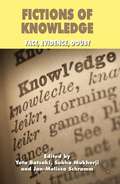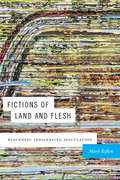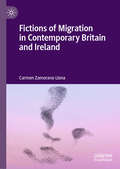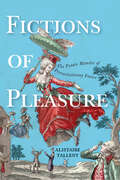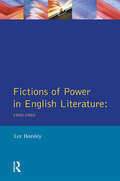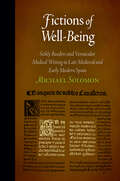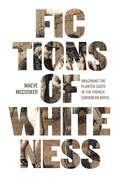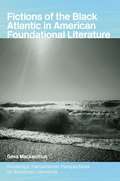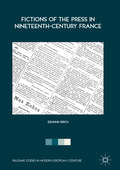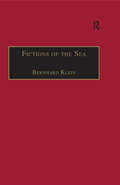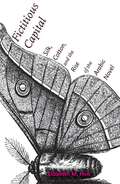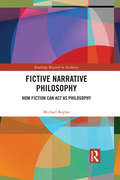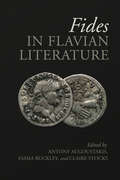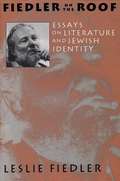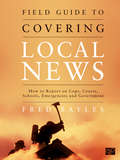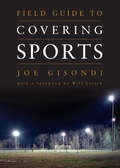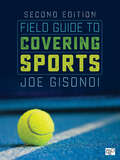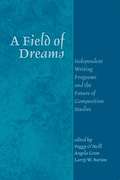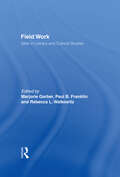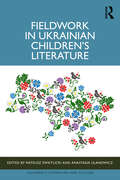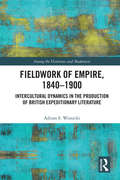- Table View
- List View
Fictions of Knowledge
by Jan-Melissa Schramm Yota Batsaki Subha MukherjiLocating literature at the intersection of distinct areas of thinking on the nature, scope and methods of knowledge - philosophy, theology, science, and the law - this book engages with literary texts across periods and genres to address questions of probability, problems of evidence, the uses of experiment and the poetics and ethics of doubt.
Fictions of Land and Flesh: Blackness, Indigeneity, Speculation
by Mark RifkinIn Fictions of Land and Flesh Mark Rifkin explores the impasses that arise in seeking to connect Black and Indigenous movements, turning to speculative fiction to understand those difficulties and envision productive ways of addressing them. Against efforts to subsume varied forms of resistance into a single framework in the name of solidarity, Rifkin argues that Black and Indigenous political struggles are oriented in distinct ways, following their own lines of development and contestation. Rifkin suggests how movement between the two can be approached as something of a speculative leap in which the terms and dynamics of one are disoriented in the encounter with the other. Futurist fiction provides a compelling site for exploring such disjunctions. Through analyses of works by Octavia Butler, Walter Mosley, Nalo Hopkinson, Melissa Tantaquidgeon Zobel, and others, the book illustrates how ideas about fungibility, fugitivity, carcerality, marronage, sovereignty, placemaking, and governance shape the ways Black and Indigenous intellectuals narrate the past, present, and future. In turning to speculative fiction, Rifkin illustrates how speculation as a process provides conceptual and ethical resources for recognizing difference while engaging across it.
Fictions of Migration in Contemporary Britain and Ireland
by Carmen Zamorano LlenaThis book examines how the transcultural and transnational migration of people, texts, and ideas has transformed the paradigm of national literature, with Britain and Ireland as case studies. The study questions definitions of migration and migrant literature that focus solely on the work of authors with migrant backgrounds, and suggests that migration is not extraneous but intrinsic to contemporary understandings of national literature in a global context. The fictional work of authors such as Caryl Phillips, Colum McCann, Abdulrazak Gurnah, Rose Tremain, Elif Shafak, and Evelyn Conlon is analysed from a variety of perspectives, including transculturality, cosmopolitanism, and Afropolitanism, so as to emphasise how their work fosters an understanding of national literature, as well as of individual and collective identities, based on transborder interconnectivity.
Fictions of Pleasure: The Putain Memoirs of Prerevolutionary France (EARLY MODERN FEMINISMS)
by Alistaire TallentOut of the libertine literary tradition of eighteenth-century France emerged over a dozen memoir novels of female libertines who eagerly take up sex work as a means of escape from the patriarchal control of fathers and husbands to pursue pleasure, wealth, and personal independence outside the private, domestic sphere. In these anonymously published novels, the heroines proudly declare themselves prostitutes, or putains, and use the desire they arouse, the professional skills they develop, and the network of female friends they create to exploit, humiliate, and financially ruin wealthy and powerful men. In pursuing their desires, the putains challenge contemporary notions of womanhood and expose the injustices of ancien-régime France. Until the French Revolution spelled the end of the genre, these novels proposed not only an appealing libertine utopia in which libertine women enjoy the same benefits as their male counterparts but also entirely new ways of looking at systems of power, gender, and sexuality.
Fictions of Power in English Literature: 1900-1950 (Longman Studies In Twentieth Century Literature)
by Lee HorsleyAs a result of its imperial role, Britain was closely involved with such romantic and disruptive myths of power such as the imperial adventure hero and the self-deified charismatic leader. Lee Horsley explores fictional representations of political power during this period, surveying a wide range of texts from the adventure story, romance, thriller and science fiction to the novels of Conrad, Huxley, Orwell and Greene.
Fictions of Well-Being: Sickly Readers and Vernacular Medical Writing in Late Medieval and Early Modern Spain
by Michael SolomonFrom the fourteenth through the sixteenth centuries in Spain, health-related information in the vernacular began to circulate widely in treatises, compendiums, manuals, plague tracts, summaries, encyclopedias, and recipe collections. These were often the work of concerned physicians who attempted to refashion medical information to appeal to nonprofessionals. In Fictions of Well-Being Michael Solomon explores the shaping of this audience of sickly readers, highly motivated individuals who, when confronted with the painful, disruptive, and often alienating conditions of physical disorder, looked for relief in books.Vernacular medical writing from late medieval and early modern Spain emerged from the interrelated imperatives to address the immediate or future hygienic and pathological needs of the patient while promoting the reputation and learned credentials of the physician. For sickly readers, a medical treatise was more than just a collection of technical information; such a work implied that they could do with a medical text what the physician normally did at the bedside. In their imagination, the treatise became a type of palpable instrument that encouraged the reader to take advantage of its possible use and benefits. In these fictions of well-being, we may see the antecedents of the self-help and popular medical books so prominent on today's best-seller lists.
Fictions of Whiteness: Imagining the Planter Caste in the French Caribbean Novel (New World Studies)
by Maeve McCuskerThe Antilles remain a society preoccupied with gradations of skin color and with the social hierarchies that largely reflect, or are determined by, racial identity. Yet francophone postcolonial studies have largely overlooked a key figure in plantation literature: the béké, the white Creole master. A foundational presence in the collective Antillean imaginary, the béké is a reviled character associated both with the trauma of slavery and with continuing economic dominance, a figure of desire at once fantasized and fetishized.The first book-length study to engage with the literary construction of whiteness in the francophone Caribbean, Fictions of Whiteness examines the neglected béké figure in the longer history of Antillean literature and culture. Maeve McCusker examines representation of the white Creole across two centuries and a range of ideological contexts, from early nineteenth-century békés such as Louis de Maynard and Joseph Levilloux; to canonical twentieth- and twenty-first-century novelists such as Édouard Glissant, Patrick Chamoiseau, Raphaël Confiant, and Maryse Condé; extending to lesser-known authors such as Vincent Placoly and Marie-Reine de Jaham, and including entirely obscure writers such as Henri Micaux. These close analyses illuminate the contradictions and paradoxes of white identity in the Caribbean’s vieilles colonies, laboratories in which the colonial mission took shape and that remain haunted by the specter of slavery.New World Studies
Fictions of Witness in the Confessio Amantis (The New Middle Ages)
by Joel FredellFictions of Witness in the Confessio Amantis details the first years of the Confessio’s material history and offers a major revision to a century’s old narrative of political revision and conversion around the trauma of 1400. Joel Fredell argues for “late stage” revisions by Gower to his great poem in Middle English from the late 1390s up to Gower’s death in 1408. This approach, new to scholarship for Ricardian and Lancastrian literature, demands profound re-evaluation of Gower's poetic persona and its entanglement in the opening and closing books of the Confessio. It offers a reassessment of the political and literary relationships between versions dedicated to Richard II and Henry IV. It repositions Gower's laureate status in a London world of deluxe book production that created a canon of Ricardian poets linked to their fifteenth-century inheritors. Finally, it identifies for the first time how late medieval authors designed their poetry as fictional artifacts that witness history from quasi-chronicles like Maidstone’s Concordia or Richard the Redeless, quasi-petitions like the Lollard “Petition to the King and Parliament,” quasi-epistles that begin so many texts, quasi-transcripts such as the Record and Process of the Deposition of Richard II, and so on.
Fictions of Youth
by Simona BondavalliFictions of Youth is a comprehensive examination of adolescence as an aesthetic, sociological, and ideological category in Pier Paolo Pasolini's prose, poetry, and cinema. Simona Bondavalli's book explores the multiple ways in which youth, real and imagined, shaped Pasolini's poetics and critical positions and shows how Pasolini's works became the basis for representations of contemporary young people, particularly Italians. From Pasolini's own coming of age under Fascism in the 1940s to the consumer capitalism of the 1970s, youth stood for innocence, vitality, and rebellion. Pasolini's representations of youth reflected and shaped those ideas.Offering a systematic treatment of youth and adolescence within Pasolini's eclectic body of work, Fictions of Youth provides both a broad overview of the changing nature of youth within Italian modernity and an in-depth study of Pasolini's significant contribution to that transformation.
Fictions of the Black Atlantic in American Foundational Literature (Routledge Transnational Perspectives on American Literature)
by Gesa MackenthunThis book is a significant contribution to existing research on the themes of race and slavery in the founding literature of the United States. It extends the boundaries of existing research by locating race and slavery within a transnational and 'oceanic' framework. The author applies critical concepts developed within postcolonial theory to American texts written between the national emergence of the United States and the Civil War, in order to uncover metaphors of the colonial and imperial 'unconscious' in America's foundational writing. The book analyses the writings of canonized authors such as Charles Brockden Brown, James Fenimore Cooper, Edgar Allan Poe, and Herman Melville alongside those of lesser known writers like Olaudah Equiano, Royall Tyler, Frederick Douglass, Martin Delany, and Maxwell Philip, and situates them within the colonial, and 'postcolonial', context of the slave-based economic system of the Black Atlantic. While placing the transatlantic slave trade on the map of American Studies and viewing it in conjunction with American imperial ambitions in the Pacific, Fictions of the Black Atlantic in American Foundational Literature also adds a historical dimension to present discussions about the 'ambivalence' of postcoloniality.
Fictions of the Press in Nineteenth-Century France (Palgrave Studies in Modern European Literature)
by Edmund BirchThis book explores how writers responded to the rise of the newspaper over the course of the nineteenth century. Taking as its subject the ceaseless intertwining of fiction and journalism at this time, it tracks the representation of newspapers and journalists in works by Honoré de Balzac, Edmond and Jules de Goncourt, and Guy de Maupassant. This was an era in which novels were published in newspapers and novelists worked as journalists. In France, fiction was to prove an utterly crucial presence at the newspaper’s heart, with a gilded array of predominant literary figures active in journalism. Today, few in search of a novel would turn to the pages of a daily newspaper. But what are usually cast as discrete realms – fiction and journalism – came, in the nineteenth century, to occupy the same space, a point which complicates our sense of the cultural history of French literature.
Fictions of the Sea: Critical Perspectives on the Ocean in British Literature and Culture
by Bernhard KleinThis timely collection brings together twelve original essays on the cultural meaning of the sea in British literature and history, from early modern times to the present. Interdisciplinary in conception, it charts metaphorical and material links between the idea of the sea in the cultural imagination and its significance for the social and political history of Britain, offering a fresh analysis of the impact of the ocean on the formation of British cultural identities. Among the cultural and literary artifacts considered are early modern legal treatises on marine boundaries, Renaissance and Romantic poetry, 19th- and 20th-century novels, popular sea songs, recent Hollywood films, as well as a diverse range of historical and critical writings. Writers discussed include Shakespeare, Milton, Coleridge, Scott, Conrad, du Maurier, Unsworth, O'Brian, and others. All these cultural and literary 'fictions of the sea' are set in relation to wider issues relevant to maritime history and the historical experience of seafaring: problems of navigation and orientation, piracy, empire, colonialism, slavery, multi-ethnic shipboard communities, masculinity, gender relations. By combining the interests of three related but distinct areas of study-the analysis of sea fiction, critical maritime history, and cultural studies-in a focus upon the historical meaning of the sea in relation to its textual and cultural representation, Fictions of the Sea offers an original contribution to the practice of existing disciplines.
Fictitious Capital: Silk, Cotton, and the Rise of the Arabic Novel
by Elizabeth M. HoltThe ups and downs of silk, cotton, and stocks syncopated with serialized novels in the late-nineteenth-century Arabic press: Time itself was changing. Novels of debt, dissimulation, and risk begin to appear in Arabic at a moment when France and Britain were unseating the Ottoman legacy in Beirut, Cairo, and beyond. Amid booms and crashes, serialized Arabic fiction and finance at once tell the other’s story.While scholars of Arabic often write of a Nahdah, a sense of renaissance, Fictitious Capital argues instead that we read the trope of Nahdah as Walter Benjamin might have, as “one of the monuments of the bourgeoisie that [are] already in ruins.” Financial speculation engendered an anxious mixture of hope and fear formally expressed in the mingling of financial news and serialized novels in such Arabic journals as Al-Jinān, Al-Muqtataf, and Al-Hilāl. Holt recasts the historiography of the Nahdah, showing its sense of rise and renaissance to be a utopian, imperially mediated narrative of capital that encrypted its inevitable counterpart, capital flight.
Fictive Narrative Philosophy: How Fiction Can Act as Philosophy (Routledge Research in Aesthetics)
by Michael BoylanWhat is the philosophical voice within literature? Does literature have a voice of its own? Can this voice really be philosophical in its own right? In this book, Michael Boylan argues that some literary works indeed can make their own unique claims in different areas of philosophy. He calls this method fictive narrative philosophy. The first part of the book presents an overview of traditional thinking about philosophy and literature across classical, modern, and contemporary periods. It does not seek to denigrate these methods of studying literature, but rather to ask more of them. The second part then sets out a rigorous definition of what constitutes fictive narrative philosophy. This definition outlines detailed conceptions of the methods of presentation, audience engagement, logical mechanics, and constructional devices of fictive narrative philosophy. The author brings this definition to bear on individual authors and works that can be considered prime examples of fictive narrative philosophy. Finally, the book sets out why and when fictive narratives might be more favorable than traditional philosophical discourse, and how the concept of fictive narrative philosophy can move teaching and scholarship forward in a positive direction. Fictive Narrative Philosophy presents an entirely new and unique approach in which literature can be a form of philosophy. It will appeal to scholars and upper-level students interested in philosophy and literature.
Fides in Flavian Literature (Phoenix Supplementary Volumes #56)
Fides in Flavian Literature explores the ideology of "good faith" (fides) during the time of the emperors Vespasian, Titus, and Domitian (69–96 CE), the new imperial dynasty that gained power in the wake of the civil wars of the period. The contributors to this volume consider the significance and semantic range of this Roman value in works that deal in myth, contemporary poetry, and history in both prose and verse. Though it does not claim to offer the comprehensive "last word" on fides in Flavian Rome, the book aims to show that fides in this period was subjected to a particularly striking and special brand of contestation and reconceptualization, used to interrogate the broad cultural changes and anxieties of the Flavian period as well as connect to a republican and imperial past. The editors argue that fides was both a vehicle for reconciliation and a means to test the nature of "good faith" in the wake of a devastating and divisive period in Roman history.
Fiedler on the Roof: Essays on Literature and Jewish Identity
by Leslie A. FiedlerContents: The roots of anti-Semitism : a view from Italy - Bloom on Joyce, or, Jokey for Jacob -Joyce and Jewish consciousness - The Christian-ness of the Jewish-American writer - Isaac Bashevis Singer, or, The American-ness of the American-Jewish writer - Why is the grail knight Jewish? : a Passover meditation - William Styron's Sophie's choice - Going for the long ball - Growing up post-Jewish - the many names of S. Levin : an essay in genre criticism - a meditation of the Book of Job - In every generation : a meditation on the two Holocausts.
Field Guide to Covering Local News: How to Report on Cops, Courts, Schools, Emergencies and Government
by Fred BaylesIn the latest installment of the Field Guide series, Fred Bayles takes you step-by-step through the process of identifying and covering the events and issues that matter most to your community. For the five local beats—cops, courts, emergencies, schools, and government—you'll learn where to go for information and how to organize and present the stories your neighbors want and need. An overview of tools and techniques include tips on how to find sources, conduct interviews, work with editors, tap the power of the crowd and think multimedia. Then, for each beat, you'll get specifics on:People: The best official and unofficial sources of info, and what to ask them. Places: Where to go on the beat, and what to look for while you're there.Documents: Where to find records in offices and online, how to decipher and use them. Stories: Overview of common story types and how to go beyond them.Resources: Glossary of key terms, checklists, helpful web links.
Field Guide to Covering Sports
by Joe GisondiQuickly moving beyond general guidance about sports writing, Joe Gisondi focuses on the nitty-gritty, with hands-on, practical advice on covering 20 specific sports. From auto racing to wrestling, you'll find tips on the seemingly straightforward—where to stand on the sideline and how to identify a key player—along with the more specialized—figuring out shot selection in lacrosse and understanding a coxswain's call for a harder stroke in rowing. Preparing you for just about any game, match, meet, race, regatta or tournament you're likely to cover, Field Guide to Covering Sports is the ideal go-to resource to have on hand as you master the beat.
Field Guide to Covering Sports
by Joe GisondiTransform yourself from sports fan to professional sports journalist Field Guide to Covering Sports, Second Edition goes beyond general guidance about sports writing, offering readers practical advice on covering 20 specific sports. From auto racing to wrestling, author Joe Gisondi gives tips on the seemingly straightforward—like where to stand on the sideline and how to identify a key player—along with the more specialized—such as figuring out shot selection in lacrosse and understanding a coxswain’s call for a harder stroke in rowing. In the new Second Edition, readers also explore sports reporting across multimedia platforms, developing a foundational understanding for social media, mobile media, visual storytelling, writing for television and radio, and applying sabermetrics. Fully revised with new examples and updated information to give readers confidence in covering just about any game, match, meet, race, regatta or tournament, Field Guide to Covering Sports, Second Edition is the ideal go-to resource to have on hand when mastering the beat.
Field Guide to Covering Sports
by Joe GisondiTransform yourself from sports fan to professional sports journalist Field Guide to Covering Sports, Second Edition goes beyond general guidance about sports writing, offering readers practical advice on covering 20 specific sports. From auto racing to wrestling, author Joe Gisondi gives tips on the seemingly straightforward—like where to stand on the sideline and how to identify a key player—along with the more specialized—such as figuring out shot selection in lacrosse and understanding a coxswain’s call for a harder stroke in rowing. In the new Second Edition, readers also explore sports reporting across multimedia platforms, developing a foundational understanding for social media, mobile media, visual storytelling, writing for television and radio, and applying sabermetrics. Fully revised with new examples and updated information to give readers confidence in covering just about any game, match, meet, race, regatta or tournament, Field Guide to Covering Sports, Second Edition is the ideal go-to resource to have on hand when mastering the beat.
Field Of Dreams: Independent Writing Programs And The Future Of Composition Studies
by Peggy O'NeillOne of the first collections to focus on independent writing programs, A Field of Dreams offers a complex picture of the experience of the stand-alone. Included here are narratives of individual programs from a wide range of institutions, exploring such issues as what institutional issues led to their independence, how independence solved or created administrative problems, how it changed the culture of the writing program and faculty sense of purpose, success, or failure. Further chapters build larger ideas about the advantages and disadvantages of stand-alone status, covering labor issues, promotion/tenure issues, institutional politics, and others. A retrospective on the famous controversy at Minnesota is included, along with a look at the long-established independent programs at Harvard and Syracuse. Finally, the book considers disciplinary questions raised by the growth of stand-alone programs. Authors here respond with critique and reflection to ideas raised by other chapters—do current independent models inadvertently diminish the influence of rhetoric and composition scholarship? Do they tend to ignore the outward movement of literacy toward technology? Can they be structured to enhance interdisciplinary or writing-across-the-curriculum efforts? Can independent programs play a more influential role in the university than they do from the English department?
Field Trips: Out and About at the Newspaper
by Kitty Shea Zachary Trover Jill KalzA group of children go on a field trip for a guided tour of a newspaper, where they learn how reporters, photographers, and other staff members work together to publish a newspaper. Includes an activity.
Field Work: Sites in Literary and Cultural Studies (CultureWork: A Book Series from the Center for Literacy and Cultural Studies at Harvard)
by Marjorie Garber Rebecca L. Walkowitz Paul B. FranklinFirst published in 1996. Routledge is an imprint of Taylor & Francis, an informa company.
Fieldwork in Ukrainian Children’s Literature (Children's Literature and Culture)
by Świetlicki, Edited by MateuszFieldwork in Ukrainian Children’s Literature showcases the work of prominent scholars of children’s literature from Ukraine and the diaspora as it traces the history of books written, marketed for, and circulating among young people since the rise of Ukraine’s nationhood in the nineteenth century. This book encompasses a full range of texts and genres (e.g., fiction, nonfiction, poetry, picturebooks, graphic novels), with special attention given to the most important authors and works as defined by aesthetics (“literary excellence”), popularity, or historical and cultural significance. In its focus on ideology and historical context, the collection takes an interdisciplinary and transnational approach. It places titles and trends in broader context, considering the socio-political situation, changing taste, and the history of institutions that shape the production and reception of children’s literature. The collection addresses folklore and the beginnings of a distinct tradition of Ukrainian children’s literature produced in the nineteenth century; the role played by children’s literature in the maintenance of the Ukrainian literary tradition during the Soviet era; and the flourishing Ukrainian book market, with the appearance of numerous new genres and forms, and the growing significance of Ukrainian books around the world. The collection highlights the importance of familiarizing non-Ukrainian students and scholars of children’s literature with the richness of the country’s literary history and cultural distinctiveness. Fieldwork in Ukrainian Children’s Literature is intended primarily for scholars of children’s literature and culture, including specialists in the fields of literary studies, education, and Slavic studies.
Fieldwork of Empire, 1840-1900: Intercultural Dynamics in the Production of British Expeditionary Literature (Among the Victorians and Modernists)
by Adrian S. WisnickiFieldwork of Empire, 1840-1900: Intercultural Dynamics in the Production of British Expeditionary Literature examines the impact of non-western cultural, political, and social forces and agencies on the production of British expeditionary literature; it is a project of recovery. The book argues that such non-western impact was considerable, that it shaped the discursive and material dimensions of expeditionary literature, and that the impact extends to diverse materials from the expeditionary archive at a scale and depth that critics have previously not acknowledged. The focus of the study falls on Victorian expeditionary literature related to Africa, a continent of accelerating British imperial interest in the nineteenth century, but the study’s findings have the potential to inform scholarship on European expeditionary, imperial, and colonial literature from a wide variety of periods and locations. The book’s analysis is illustrative, not comprehensive. Each chapter targets intercultural encounters and expeditionary literature associated with a specific time period and African region or location. The book suggests that future scholarship – especially in areas such as expeditionary history, geography, cartography, travel writing studies, and book history – needs to adopt much more of a localized, non-western focus if it is to offer a full account of the production of expeditionary discourse and literature.
